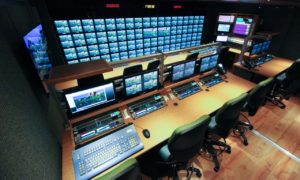Going Remote on the Road: How The Switch, Game Creek Video Partnered to Reset the Production Model for U.S. Regional Sports Networks
Story Highlights
Introduction
We are witnessing a new era of innovation in the sports broadcast space. The rapid adoption of remote production methods has seen a massive acceleration over the past two years. Due to pressing calls for reductions in budgetary and travel costs while also addressing increased safety and staffing mitigation measures during the pandemic, the broadcast industry had to adapt and engage cost-effective alternatives to elevate live productions and fan engagement in the most efficient and agile manner.
Remote production is now positioned to play a central role in the coverage of all top-tier sporting events. Although REMI or At-Home Production workflows were not a new concept for mainstream sports at the outset of the pandemic, remote production was largely considered a longer-term goal on future roadmaps. It was the exception rather than the rule – and in the eyes of some producers of live events, unproven. That is far from the case today.
Today, many media organizations plan to extend and enhance tailored combinations of remote event workflows, presented in a secure and systematic package, within this evolving and augmented live sports, social media, and streaming ecosystem. A survey of 100 media sector executives from over 30 countries around the globe by telecommunications, media and technology consulting firm Altman Solon showed that 62% anticipate expanding collaboration tools in support of remote workflows post-pandemic.
With all this in mind, The Switch and Game Creek Video partnered this year to support regional sports networks (RSNs) shifting to a remote production model. The partnership enables RSNs across the United States to make remote production of away games a more integral part of their live broadcast operations through a redundant and resolute remote production design.

RSN Renaissance
RSNs across North America have traditionally faced a perennial challenge when broadcasting away games. To capture the same quality and consistency of their home broadcast product, many deployed full production crews and full-scale Mobile Production Units for every road game – leading to financial constraints due to large side-by-side footprints onsite, high crew and talent travel and accommodation budgets, as well as remote staffing or consistency concerns.
Using the North American RSN market as a prime example, an RSN covering MLB, NHL, and NBA games is looking at potentially producing 300+ road games during the regular season. And that is not counting playoffs, pre-season, or other league, collegiate, and niche events throughout the year. In turn, they also continue to deal with the mounting challenges of crewing shortages, safety protocols, security restrictions and financial pressures.
To deal with the challenge of enabling remote productions in 100+ venues, some of the biggest RSN’s have turned to Game Creek and The Switch for their combined mobile and remote expertise and experience – and the quality of equipment, connectivity and support they can provide. The result is the development of an innovative and resourceful production set-up to support RSNs in their shift to remote production of away games.
Always There
To support multiple remote productions from venues across the US and Canada, Game Creek and The Switch leveraged their combined technologies, equipment, and infrastructures to direct, distribute, monitor, and support their entire production ecosystem.
Through this collaboration, The Switch and Game Creek Video were able to develop an inventive architecture, utilizing a new end-to-end Remote Access Production Service (RAPS) workflow, with both redundant 10 GB Switch network infrastructure and fully equipped GCV RAPS control rooms installed and monitored at the RSN’s home facility.
The pandemic further highlighted the economic savings and logistical benefits of remote production for RSN road games and some pre-season games. It also became evident that this approach represented a lasting production practice, providing broadcasters with the controls to seamlessly integrate isolated camera feeds, audio channels and file-based workflows between their remote event sites, their “home” broadcast center facilities, and additional on-net environments – like The Switch’s production control rooms and personnel in Burbank, CA.
By creating permanent remote production facilities at their network headquarters, the majority of broadcasters and other sports rightsholders are now drawing on a broader package of production and delivery service options, including mobile site, data/FTP, dedicated internet access, IP transport, and cloud elements, while substantially reducing their carbon footprint and stress level over each live broadcast.
The RAPS rooms built by Game Creek represent innovation in the remote production space – created specifically for remote broadcast of road games by RSNs with up to eight remote positions. There are 15 RAPS rooms around the country that are now operational. Game Creek also provides mobile units for the onsite teams, with a virtual private line link between the RAPS room and the production truck.
On any given night, a minimum of seven remote positions, including the producer, director, the tape team, and graphics operators, utilize an RSN’s centralized RAPS control room/s, with seven to 15 crew members onsite, depending on how many camera positions there are. The audio and video crews are still needed onsite to patch sound and set up the cameras. A technical director (TD) is also sent to the venue for two reasons: first, the capital expenditure for supplemental switcher consoles for every RAPS room is costly; second, in an emergency scenario, the TD is physically sitting in the truck and could still cut the show – with The Switch providing the necessary redundancy and backhaul transport needed for business continuity and distribution requirements.
The low-latency connectivity provided through The Switch’s private fiber network is critical to the success of these remote productions. Take an example from a Major League Baseball away game. When a batter hits the ball, the crew needs to be able to make a call on how they are going to cover it. They need to determine where the ball is going almost instantly to be able to decide what camera they are going to switch to in real time. The lower the latency, the more readied the director is to make an instantaneous cut or adjustment without delay. The result is they are still able to tell the exact same story that they were telling prior to being in a RAPS room.
Always On
The Switch-Game Creek solution has already been deployed by leading regional sports players across the U.S. – including multiple premiere Regional Sports Networks in the Baltimore, Boston, Chicago, Philadelphia, San Francisco, San Jose, and Washington D.C. markets – all mutual clients and long-time partners of both companies.
Considering that the number of away games and other off-site live sporting events covered by RSNs throughout a given year can be upwards of 300 games – or more in some cases – the ability to use seasoned salaried staffing from within their organization and home markets delivers a premiere quality and brand consistency that is perceptible to their fans and sponsors. By eliminating any geographical or generational crewing limitations, Game Creek and The Switch have unlocked the limitless potential for RSNs to maximize staffing utilizations. They can produce multiple shows in a day from their safe and familiar home RAPS room – easily pivoting the production team to handle, for example, a 1 pm MLB baseball game and an 8 pm NHL hockey game.

Game Creek’s customized IP production platform, when combined with The Switch’s unparalleled venue and 100G network backbone, hands the controls over to the RSNs and provides the same high-quality, high-availability, and low latency offered in live onsite productions. This collective design ensures that producers, technicians, camera crew, and talent can see every camera angle and communicate efficiently to make real-time adjustments without delay – regardless of where they are located across the country.
Additionally, on game days, Game Creek also provides mobile units for the onsite teams, while The Switch delivers multiple video paths, ethernet private line connection, and dedicated Internet services between GCV’s production unit located at any major North American sports venue and the RSN Home facility as well.
Conclusion
The last two years have tested the resiliency and capabilities of global sports leagues, broadcasters, their vendors, and other live content producers, all of whom had to rapidly rise to the occasion to get back on the air quickly and safely following a time of unprecedented event cancelation and loss of content. In spite of this uncertainty, this fresh landscape grants us the opportunity to reassess and refresh previous workflows and workplace norms, as well as embrace changes to bridge the gap between well-worn practices, economies of scale and the emerging production models and technologies to overcome each new challenge in a post-Covid-19 environment.
The broadcast industry has now fully embraced the resourceful remote production models and technological approaches that have long been proven and put into live action by The Switch and Game Creek. As we return to a “New Normal”, we are confident that rightsholders, leagues, teams, and the industry will continue to amplify our efforts to cultivate and encourage this paradigm shift towards remote and cloud production workflows, further embracing new technologies, protocols, AR/VR, and data-driven DTC demands like sports betting, NFT’s, and blockchain.
